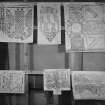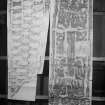Meigle
Hogback Stone (Early Medieval)
Site Name Meigle
Classification Hogback Stone (Early Medieval)
Alternative Name(s) Meigle Museum; Meigle Stones; Meigle No. 25
Canmore ID 30855
Site Number NO24SE 25.25
NGR NO 2872 4459
Datum OSGB36 - NGR
Permalink http://canmore.org.uk/site/30855
- Council Perth And Kinross
- Parish Meigle
- Former Region Tayside
- Former District Perth And Kinross
- Former County Perthshire
Meigle 25, Perthshire, hogback gravestone
Measurements: L 1.54m, W 0.31m tapering to 0.25m, H 0.56m tapering to 0.31m.
Stone type: sandstone
Place of discovery: NO 2873 4460
Present location: in Meigle Museum.
Evidence for discovery: none, presumably found in the churchyard.
Present condition: a damaged area to the top ridge and some battering at the base.
Description
This wedge-shaped monument is carved in relief on both long sides and on the lower end-panel. The higher end-panel is plain, which may suggest that it was designed to abut an upright slab. Both side-panels are carved with a narrow vertical strip of interlace at the higher end and three horizontal rows of large concave-sided tegulae or roof-tiles, and the lower end-panel has two rows.
Along the ridge lies an elongated beast, its had facing outwards from the higher end and a fish-tail at the top of the lower end-panel. Its body is damaged and worn but clearly was carved with interlace, and its head has large oval eyes, triangular ears and a corrugated snout.
Date: late tenth century.
References: Stuart 1867, pl 131; ECMS pt 3, 338-9; Lang 1974, 215, 229.
Desk-based information compiled by A Ritchie 2019.
Publication Account (1964)
NO24SE 25.25 2872 4459.
No. 25 Recumbent hog-backed grave-stone: the thick decorated ridge ends in a beast's head, as though the ridge were itself a snake-like creature: the sides are worked in three rows of scales or tiles. Note the beautiful modelling of the body, undulating yet firm, instantly recalling the body of a fish or animal.
S Cruden 1964
Note (1990)
NO24SE 25.25 2872 4459.
Allen described this unusual hogback monument as 'shaped like a boat turned bottom upwards (having one end vertical and the other sloping, and with a keel-like ridge along the top)'. Measuring 1.48m in overall length, 0.33m in width at the head and 0.24m at the end and some 0.55m in maximum height, it bears tegulated decoration (in the form of shingles or roof tiles) along both sides, and interlace ornament along the ridge. At the head of the slab the ridge terminates in an outward-facing beast's head with backward-sweeping pointed ears; the tip of its raised snout protrudes a little beyond the end of the stone. Lang has compared the style to that of the terminal beasts of NO24SE 25.05. The 'feet' of the beast will be described below. The sides of the slab are decorated with three rows of concave tegulae. On each side of the head of the slab there is a vertical panel of interlace ornament. At the foot of the stone the 'keel-like' ridge merges with the slanting end to form a gabled panel, at the top of which the rear-quarters and two 'legs' of the beast appear to have been incised; the main part of the panel is taken up with two rows of tegulae. Information from RCAHMS (JNGR) 1990. J R Allen and J Anderson 1903; J T Lang 1975.










































